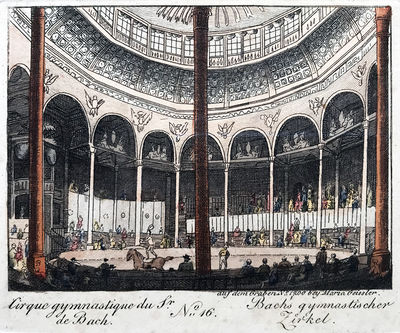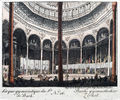Circus Gymnasticus
From Circopedia
By Dominique Jando
The "Circus im Prater"
The Circus Gymnasticus (Gymnastischer Zirkel, later known as Circus im Prater) was one of the earliest permanent circuses built in continental Europe. It had been designed by the fashionable Austrian architect Joseph Kornhäusel for the Latvian equestrian Christoph de Bach (1768-1834), who had settled in Austria around 1805. The Circus Gymnasticus’s elegant building was erected in 1808 on the Prater—the old Imperial hunting ground that had become Vienna’s favorite park, and a focal point for fairgrounds amusements.
It was a large structure shaped as a sixteen-sided polygon, built on a heavy wooden frame with walls covered with stones. Its roof, covered with copper, was supported by two circular rows of fourteen columns, and topped by a cupola above the ring, with large glass windows around its drum wich provided sunlight—since the performances had to be given in matinee only, so as not to compete with Vienna’s patented theaters. Its façade fronted an extension containing the foyer, with stairs leading to the Imperial box and eighteen private boxes on the balcony facing the ring entrance. Another extension at the back of the building contained the stables, which could accommodate 28 horses and expanded under the seating at each side of the ring entrance.
The circus was said to accommodate 3,000 spectators: It is doubtful that it ever happened to be full to this capacity, but on a full-house day, the overflow of spectators were packed on the bleachers and in the standing-room-only promenoir (or promenade) running behind them at balcony level. A platform for the orchestra stood over the ring entrance. This circular design was reminiscent of Astley’s old Royal Grove in London, and didn’t follow the more modern concept of amphitheaters designed with a ring and a stage, such as those used by Charles Hughes, the Franconis, and by Astley himself. It opened to the public on June 6, 1808, and became immediately successful.
Laura de Bach and Louis Soullier
There is a good reason for the Circus Gymnasticus architectural choice: Christoph de Bach was first and foremost an equestrian and riding master, and the Circus Gymnasticus was used for riding lessons in the morning (as Astley had done with his first Riding School) and for performances with an emphasis on equestrianism in the afternoon. De Bach didn’t have the theatrical ambitions of a Charles Dibdin, Hughes’s partner—which forced their competitor, Philip Astley, to follow suit. Furthermore, de Bach, who had been a pupil of Pierre Mahyeu, belonged to the tradition of the Spanish riding masters whose influence defined circus arts in Germany and Austria—and not to the English tradition of Hughes and Astley (and by extension, the Franconis).De Bach and his company performed six months each year at the Circus Gymnasticus in Vienna, atarting on Easter Monday, and spent the rest of the year touring the Austrian Empire, the German states and the Italian kingdoms. During Christoph de Bach’s reign, the Circus Gymnasticus had one of Europe’s finest companies of performers, including at a time or another such luminaries as the superb equestrian Alessandro Guerra (who was de Bach’s son-in-law); the ropedancer Jean Ravel; the clown and tumbler Ludovico Viool; Gatanno Ciniselli, who was to settle in Russia; the equestrienneA female equestrian, or horse trainer, horse presenter, or acrobat on horseback. Virginie Kennebel; and de Bach’s second wife, the ballerina on horseback Laura de Bach.
Upon the death of Christoph de Bach on April 12, 1834, the Circus Gymnasticus passed into the hands of his widow, Laura de Bach, who married again with the peripatetic French equestrian and director Louis Soullier, and made him co-director of the company. They soon went on to touring the world and the circus was rented out to other companies. They returned to Vienna in 1846, and enlarged parts of the old building—but it was too late: the circus was never properly maintained and was in a sorry state of disrepair, and business was bad. Laura de Bach and Louis Soullier dissolved their company in 1847 and left Vienna. By 1852, when the building was sold at auction for 6,000 florins, it was in such a sorry state that it had to be demolished. The following year, Ernst Jakob Renz erected a new circus building on Großen Fuhrmanngasse (which was renamed in 1862 Zirkusgasse). Nonetheless, in subsequent years, traveling circus companies continued to erect temporary constructions on the old Circus Gymnasticus's site.
Image Gallery
- Circus Gymnasticus 1815.jpg
Circus Gymnasticus on the Prater (1815)
- Alessandro Guerra.jpg
Alessandro Guerra at the Circus Gymnasticus









